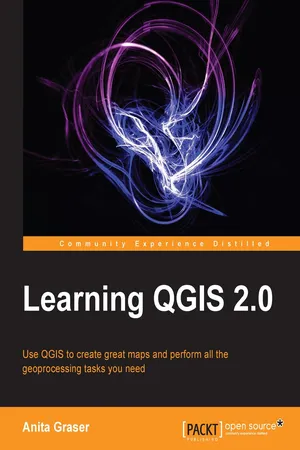![]()
![]()
Table of Contents
Learning QGIS 2.0
Credits
About the Author
About the Reviewers
www.PacktPub.com
Support files, eBooks, discount offers and more
Why Subscribe?
Free Access for Packt account holders
Preface
What this book covers
Who this book is for
Conventions
Reader feedback
Customer support
Errata
Piracy
Questions
1. Getting Started with QGIS
Installing QGIS
Installing on Windows
Installing on Ubuntu
Running QGIS for the first time
Introducing the QGIS user interface
Summary
2. Viewing Spatial Data
Loading vector data from files
Dealing with coordinate reference systems
Loading raster files
Georeferencing raster maps
Loading data from databases
Loading data from web services
Styling raster layers
Styling vector layers
Creating point styles – an example of an airport style
Creating line styles – an example of river or road styles
Creating polygon styles – an example of a landmass style
Loading background maps
Summary
3. Data Creation and Editing
Creating new vector layers
Working with feature selection tools
Editing vector geometries
Using the measuring tools
Editing attributes
Reprojecting and converting vector and raster data
Joining tabular data
Summary
4. Spatial Analysis
Clipping rasters
Analyzing elevation / terrain data
Raster calculator
Converting between rasters and vectors
Accessing raster and vector layer statistics
Creating a heatmap from points
Vector geoprocessing with Processing
Identifying features in the proximity of others
Raster sampling at point locations
Mapping density with hexagonal grids
Calculating area shares within a region
Automated geoprocessing with the graphical modeler
Summary
5. Creating Great Maps
Advanced vector styling
Creating a graduated style with size-scaling
Using categorized styles
Creating a rule-based style for road layers
Labeling
Designing print maps
Summary
Index
![]()
Copyright © 2013 Packt Publishing
All rights reserved. No part of this book may be reproduced, stored in a retrieval system, or transmitted in any form or by any means, without the prior written permission of the publisher, except in the case of brief quotations embedded in critical articles or reviews.
Every effort has been made in the preparation of this book to ensure the accuracy of the information presented. However, the information contained in this book is sold without warranty, either express or implied. Neither the author, nor Packt Publishing, and its dealers and distributors will be held liable for any damages caused or alleged to be caused directly or indirectly by this book.
Packt Publishing has endeavored to provide trademark information about all of the companies and products mentioned in this book by the appropriate use of capitals. However, Packt Publishing cannot guarantee the accuracy of this information.
First published: September 2013
Production Reference: 1100913
Published by Packt Publishing Ltd.
Livery Place
35 Livery Street
Birmingham B3 2PB, UK.
ISBN 978-1-78216-748-8
www.packtpub.com
![]()
Author
Anita Graser
Reviewers
Werner Macho
Nathan Woodrow
Acquisition Editor
Kevin Colaco
Commissioning Editor
Sharvari Tawde
Technical Editor
Sonali S. Vernekar
Copy Editors
Aditya Nair
Alfida Paiva
Laxmi Subramanian
Project Coordinator
Esha Thakker
Proofreader
Paul Hindle
Indexer
Priya Subramani
Graphics
Ronak Dhruv
Production Coordinator
Manu Joseph
Cover Work
Manu Joseph
![]()
Anita Graser studied at FH Wr. Neustadt, Austria, where she graduated with a Master’s degree in Geomatics in 2010. During her studies, she acquired hands-on experience in the fields of geomarketing and transportation research. Since 2007, Anita has been working as a geographic information systems (GIS) expert with the Dynamic Transportation Systems group at the Austrian Institute of Technology, where she focuses on analyzing and visualizing spatio-temporal data and research project management. Anita is an OSGeo Charter member and QGIS team member. She has been working with GIS since 2005, and is writing a popular blog on open source GIS at anitagraser.com.
![]()
Werner Macho completed his Master’s degree at the University of Natural Resources and Life Sciences, Vienna, Austria. There he spent a long period of time as a scientist working on a range of topics. Currently, he is completing his second Master’s degree in GIS Science at the University of Salzburg, Austria, while working at linfiniti.com in Swellendam, South Africa. Werner has been working with QGIS since 2007, when he searched for an open source GIS tool to aid in his w...
